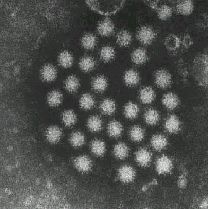Tokyo Food Safety Information Center » Good things to know » The microorganisms which cause food poisoning » Norovirus
Norovirus
Infectious gastroenteritis and food poisoning caused by norovirus tend to occur frequently in winter.
Particular care must be taken when norovirus occurs in facilities such as nurseries, schools, and welfare facilities as it can lead to mass outbreaks.
What is norovirus?
Norovirus is a virus which propagates in the human small intestine.
The International Committee on Taxonomy of Viruses chose the name “norovirus” in August 2002; before this time, it was known as “SRSV” (Small Round Structured Virus).
The “noro” in “norovirus” is derived from Norwalk Ohio, where the virus was discovered.
Characteristics

Norovirus causes gastroenteritis throughout the year with particular frequency in winter. When heated between 85 and 90° C for several seconds, norovirus loses its infectious capabilities.
Epidemiological studies have strongly identified oysters as being part of the virus’ transmission route. There have also been many cases where contamination of food by food preparers infected with norovirus have been suspected as the cause.
Norovirus is comprised of a 30 to 40 nanometer in dimeter spherical shape with a cup-shaped protein enwrapping its genes (RNA which serves as DNA for the virus).
A large variety of norovirus genotypes exist, with each corresponding to a different serotype. In recent years, the development and popularization of a new testing method (PCR) has made it possible to detect norovirus in food, clarifying the relationship between norovirus and food poisoning.
Which foods can cause norovirus infection?
Water and food contaminated with norovirus, and particularly bivalves such as oysters have been widely reported to have caused norovirus. Norovirus cannot multiply inside shellfish. Instead, it is believed that norovirus accumulates inside bivalves when their environment becomes contaminated with the virus.
Secondary infection may also be caused by contact with the stool or vomit of infected persons.
When infected persons prepare food after using the bathroom and fail to wash their hands sufficiently, the food can become contaminated with norovirus. When this food is eaten in turn, infection can occur.
What are the symptoms of norovirus infection?
The incubation period for norovirus is 24 to 48 hours. Primary symptoms include nausea, vomiting, diarrhea, stomach pain, and fever. Victims normally recover within three days.
Not all persons infected with norovirus show symptoms and some may only suffer symptoms similar to a cold. Persons with lowered immune resistance and infants may be infected after consuming just a few hundred viral particles.
What are the key points to preventing norovirus infection?
- Thoroughly cook bivalves such as oysters so that the heat penetrates all the way to their center before eating (85 to 95° C for longer than 90 seconds). Parboiling does not sufficiently heat food to remove norovirus’ ability to infect people.
- Thoroughly wash fresh foods (vegetables, fruits, etc.).
- Wash hands thoroughly after using the toilet, when preparing food, and before eating (see Let’s work together and wash our hands).
- Use only clean towels after washing hands.
[Preventing secondary infection…]
<At home, nursery, and school>
- Avoid coming in contact with the stool and vomit of infected individuals and, if contact is made, thoroughly wash and disinfect affected areas.
- When cleaning up clothing and other items contaminated by vomit and stool, use vinyl gloves and a mask.
- Wash clothing and other items contaminated with vomit and stool separately from other items.
- Soak utensils and rags used to clean up vomit and stool in chlorine bleach before washing them.
- Wipe floors contaminated with vomit using a cloth soaked in chlorine bleach and let sit for a period of time to disinfect the area.
- Once affected items have been cleaned up, wash hands thoroughly and gargle.
<For operators of facilities which handle food>
- When food prep workers show symptoms similar to a cold such as diarrhea, nausea, vomiting, stomach pain, and fever:
- Do not allow such workers to engage in food preparation.
- Have them get diagnosed at a medical institution and talk with a physician.